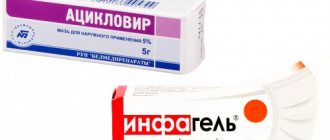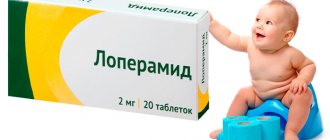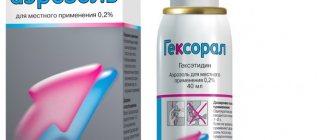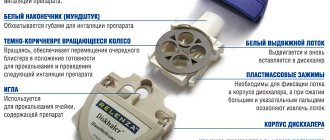- October 18, 2018
- Infectious
- Galina Fil
If a person has a viral infection in his body, then there is a very high probability that the doctor will prescribe the substance inosine pranobex, which will speed up the patient’s recovery. However, such a drug should be taken exactly according to the instructions in order to avoid side effects and to increase its effectiveness.
Release form and composition
The drug is produced in the form of tablets: white or almost white, biconvex, oblong with rounded ends or round (depending on the manufacturer), with a separating line, there may be a slight specific odor (depending on the manufacturer - 5, 10, 20, 25 or 30 pieces in a blister pack; 10, 20, 30, 40, 50 or 100 pieces in a polyethylene terephthalate/polypropylene can; in a cardboard pack 1, 2, 3, 4, 5, 10 packs or 1 can and instructions for use of Inosine pranobex).
1 tablet contains:
- active substance: inosine pranobex – 500 mg;
- additional components (depending on the manufacturer): corn or potato starch, povidone K-17 or povidone K-25, magnesium stearate, mannitol.
Medicines containing inosine pranobex
This antiviral substance cannot be purchased separately, but pharmacies sell a number of drugs that contain it as the main active ingredient.
- The drug "Isoprinosine" is available in the form of tablets of 500 mg, the number of which is 50 pieces per package. Usually its cost is about 1350 rubles.
- If 50 pieces is a lot, then you can buy the medicine “Isoprinosine”, the package of which contains 20 pills, and then its price will be about 600 rubles.
- The drug "Groprinosin" is available in the form of tablets of 500 mg, the number of which is 50 pieces per package. The cost of inosine pranobex in this case is about 1250 rubles.
- You can also buy a package of Groprinosin, which will contain 30 pills of 500 mg each, and then its cost will be 740 rubles.
- The drug "Normomed" is available in the form of tablets of 500 mg, the number of which is 50 pieces per package. Its cost is usually 1200 rubles.
- Some patients are better off taking “Normomed” syrup, containing 50 mg of the substance/ml of the drug, rather than tablets. The cost of one package of 240 ml of medicine is usually 870 rubles.
Pharmacological properties
Pharmacodynamics
Inosine pranobex is an immunostimulating agent that exhibits antiviral activity. The active substance belongs to synthetic derivatives of purine and is a complex that includes inosine and a salt of 4-acetamidobenzoic acid with N,N-dimethylamino-2-propanol in a molar ratio of 1÷3. The effect of this complex is due to the presence of inosine, the second component enhances its accessibility to lymphocytes. The drug normalizes the functions of lymphocytes under conditions of immunosuppression, stimulates the processes of blastogenesis in the monocyte population, induces the expression of membrane receptors on the surface of T-helpers, prevents a decrease in the activity of lymphocyte cells associated with the effects of glucocorticosteroids (GCS), and ensures the normal inclusion of thymidine in them.
Inosine pranobex promotes the activation of T-lymphocytes and natural killer cells, the function of T-suppressors of t-helpers. Potentiates the production of interferon-gamma (IFN-γ), immunoglobulin G (IgG), interleukins (IL)-1 and -2, suppresses the production of anti-inflammatory cytokines - IL-4 and IL-10, enhances the chemotaxis of monocytes, macrophages, neutrophil granulocytes.
The immunostimulating agent demonstrates in vivo activity against cytomegalovirus (CMV), polioviruses, human enterocytopathogenic virus (ECHO virus), as well as viruses that cause the following diseases: measles, herpes simplex, human T-cell lymphoma (type III), influenza A and B, encephalomyocarditis and equine encephalitis.
The antiviral effect of Inosine pranobex is due to the suppression of viral ribonucleic acid (RNA) and the enzyme dihydropteroate synthetase, which is involved in the replication of a number of viruses. By potentiating the synthesis of messenger RNA (mRNA) of lymphocytes inhibited by viruses, the active substance leads to a decrease in the production of viral RNA and translation of viral proteins, as well as to increased production of IFN-α and IFN-γ by lymphocytes, which have antiviral properties. The product helps to reduce the clinical manifestations of viral diseases, accelerate convalescence, and increase the body's resistance.
When used in combination, the drug increases the effect of IFN-α, zidovudine and acyclovir.
Pharmacokinetics
After oral administration, Inosine pranobex is well absorbed from the gastrointestinal tract (GIT). In the blood plasma, the maximum concentration of the immunostimulating substance is recorded after 1–2 hours.
Inosine pranobex undergoes extensive metabolism and is eliminated by the kidneys. The biotransformation of the drug corresponds to that of endogenous purine nucleotides and proceeds with the formation of uric acid. The salt of 4-acetamidobenzoic acid (4-acetamidobenzoate) is metabolized to o-acetyl glucuronide, and N,N-dimethylamino-2-propanol is metabolized to N-oxide. Cumulation of the drug in the body is not detected.
The half-life (T1/2) for N,N-dimethylamino-2-propanol is 3.5 hours, for 4-acetamidobenzoate – 50 minutes. The drug and its metabolites are excreted from the body by the kidneys within 24–48 hours.
Indications for use
- acute respiratory viral infections (ARVI), including influenza;
- infections caused by herpes virus types 1–4: herpetic keratitis, genital and labial herpes, chickenpox, herpes zoster, infectious mononucleosis caused by the Epstein-Barr virus;
- severe measles;
- CMV;
- subacute sclerosing panencephalitis (SSPE);
- papillomavirus infection (PVI): papillomas of the larynx, vocal cords (fibrous type), genital PVI in women and men, warts;
- molluscum contagiosum.
Contraindications
Absolute:
- arrhythmias;
- chronic renal failure;
- urolithiasis disease;
- gout;
- pregnancy and lactation;
- age up to 3 years (body weight up to 15–20 kg);
- hypersensitivity to any substance included in the drug.
Relative (Inosine pranobex 500 mg tablets should be used with caution): acute form of liver failure; simultaneous use with diuretics, zidovudine, xanthine oxidase inhibitors.
Existing analogues of inosine pranobex
It happens that a person cannot purchase the necessary drug due to its cost, intolerance to a component, or due to health conditions and the presence of contraindications. However, this does not mean at all that the disease cannot be cured, since pharmacies offer a number of analogues with this active substance.
- "Amiksin" contains the main active ingredient tiloron, which also blocks the virus and then removes it from the body. Suitable for the treatment of hepatitis, tuberculosis, ARVI, influenza and encephalomyelitis. Contraindications include only pregnancy, breastfeeding and children under 7 years of age. Costs about 500-700 rubles.
- "Lavomax" has a powerful antiviral and immunostimulating effect, so it is suitable for the treatment of hepatitis, influenza, herpes and any infections that are inflammatory in nature. It costs between 600-800 rubles, and the contraindications are similar to the drug “Amiksin”.
- "Kagocel" actively fights the virus thanks to the synthesis of interferon, so doctors prescribe it to patients with various infections of a viral nature. Contraindications to it will be the age of the child under 3 years, hypersensitivity and pregnancy. The drug costs 200-250 rubles.
Inosine pranobex, instructions for use: method and dosage
Inosine pranobex tablets are intended for oral use. They should be taken 3 or 4 times a day, after meals, with a small amount of water, with equal intervals between doses - 6 or 8 hours.
Children over 3 years of age, adolescents and adults should use Inosine pranobex at a daily dose of 50 mg/kg, based on the required number of tablets.
For severe infectious diseases, at the discretion of the doctor, the daily dose may be increased to 100 mg/kg, divided into 4–6 doses, while for adults the maximum daily dose should not be higher than 3000–4000 mg, for children – 50 mg/kg.
Recommended duration of treatment depending on the nature of the disease:
- acute viral lesions: course 5–14 days, after relief of symptoms, you should continue to take Inosine pranobex for 1–2 days or more, taking into account the indications;
- chronic recurrent diseases: courses of 5–10 days with breaks of 8 days; Maintenance therapy in children and adults can last no more than 30 days; the daily dose in this case can be reduced to 500–1000 mg.
Recommended doses of Inosine pranobex, frequency of administration and courses of therapy depending on the indications:
- PVI: adults 3 times/day 1000 mg, children 3–4 doses at a daily dose of 50 mg/kg, course 14–28 days in monotherapy;
- herpetic infection: adults and children - a course of 5-10 days until symptoms subside; in the asymptomatic period, in order to reduce the number of relapses in adults, the duration of maintenance treatment is 30 days, at a dose of 500 mg 2 times a day;
- cervical dysplasia associated with the human papillomavirus: adults 3 times a day, 1000 mg for 10 days, then 2-3 courses are prescribed with a break of 10-14 days;
- recurrent genital warts: adults 3 times a day, 1000 mg, children at a daily dose of 50 mg/kg, divided into 3-4 doses, as a monotherapy drug or in combination with surgical treatment for 14-28 days, then a three-time course.
Indications
Let's figure out when doctors prescribe tablets with inosine pranobex, that is, what the patient's indications for taking them should be. And with this, in fact, everything is very simple, it is recommended to take the drug with the named active substance in the case of:
- chronic or acute viral hepatitis C and B;
- diseases caused by the human papillomavirus;
- diseases caused by the herpes virus;
- infectious mononucleosis;
- chronic infectious diseases of the respiratory or genitourinary systems, with constant relapses;
- diseases caused by rhinovirus and adenovirus infections;
- influenza, ARVI and parainfluenza.
Side effects
- hepatobiliary system: often – transient increase in the activity of transaminases and alkaline phosphatase in the blood plasma;
- Gastrointestinal tract: often - loss of appetite, epigastric pain, nausea, vomiting; uncommon – constipation or diarrhea;
- nervous system: often – fatigue, headache, poor health, dizziness; infrequently – insomnia/drowsiness, nervousness;
- kidneys and urinary tract: uncommon – polyuria;
- allergic reactions: infrequently - urticaria, maculopapular rash, angioedema;
- skin and subcutaneous fat: often – rash, itching;
- laboratory and instrumental data: often - an increase in the level of urea nitrogen in the blood;
- general disorders: often – joint pain, exacerbation of gout.
Action
Now that we know about the release form of inosine pranobex, let's take a closer look at the effects of the drugs that contain it on the human body.
- The pharmacodynamics of the substance suggests that when it enters the body, it begins to affect the immune system and the cellular immune response, which damages the genetic apparatus of the virus and blocks its reproduction. Thus, immediately after taking the pill, the virus is preserved and it stops multiplying, after which the symptoms of the disease it caused gradually decrease and the person gets better.
- The pharmacokinetics of the substance suggests that it is easily and completely absorbed from the gastrointestinal tract, and its maximum concentration in the blood plasma will be reached exactly one hour after taking the tablet in the morning on an empty stomach. The therapeutic effect of taking the drug will be noticeable half an hour after taking it, and it will last for as long as six hours. After which the substance will be metabolized in the liver, and after 48 hours, judging by the reviews of doctors, it will completely leave the patient’s body.
special instructions
Before starting a course of therapy, it is necessary to consult a specialist.
Just like other antiviral drugs, Inosine pranobex demonstrates the best therapeutic effect when treatment was started immediately after the development of the first symptoms of a viral infection (preferably on the first day).
2 weeks after the start of the course, as well as monthly against the background of long-term use of the drug, it is recommended to monitor the content of uric acid in urine and blood serum. With a pronounced increase in concentration, combined use with drugs that reduce its content is possible.
It is necessary to monitor the serum level of uric acid in the blood also with concomitant use of medications that increase its concentration or impair renal function.
If long-term therapy with inosine pranobex is necessary, it is advisable to monitor the functional state of the kidneys and liver at least once a month.
Impact on the ability to drive vehicles and complex mechanisms
The effect of inosine pranobex on the ability to drive vehicles and operate other complex equipment has not been studied. However, patients performing potentially hazardous work, including driving, should be aware that the drug may cause dizziness or drowsiness.








